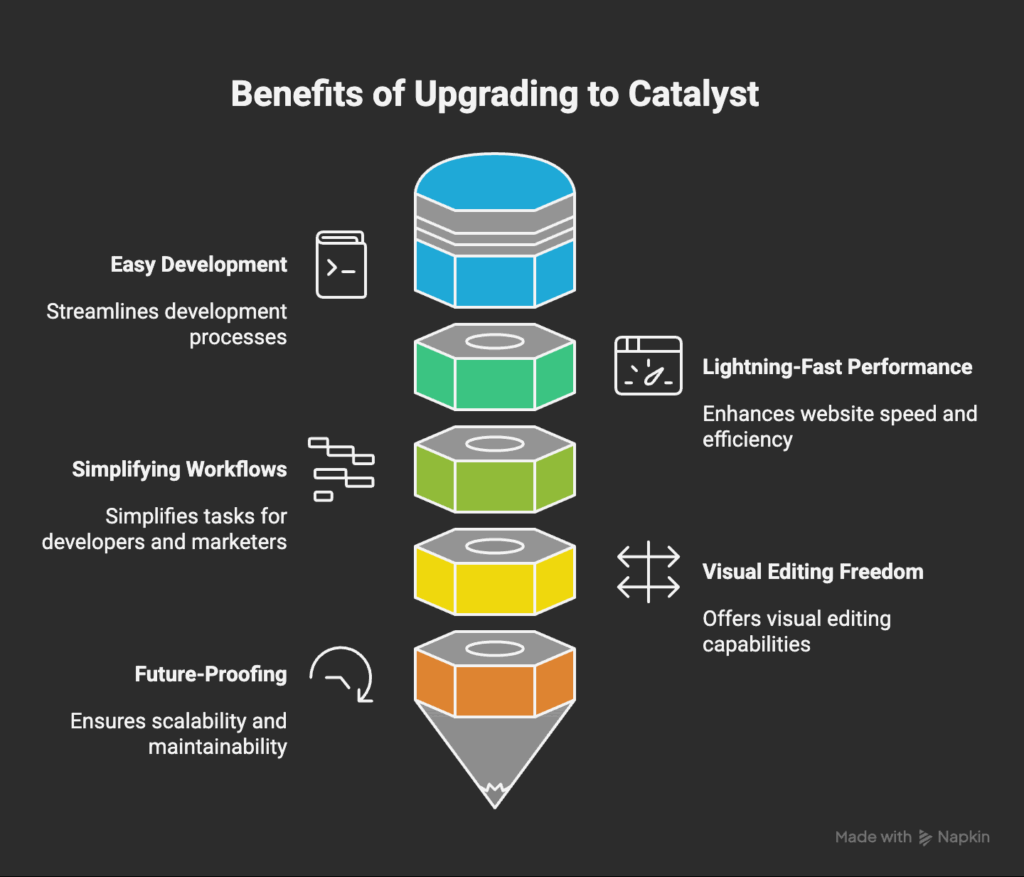
5 Reasons Why Marketers and Developers Will Love Upgrading to BigCommerce Catalyst
Success in eCommerce is possible only with constant evolution in a fast-moving market landscape. With the need for agility and personalization, eCommerce businesses are seeking speed, flexibility, and creative freedom in developing the eCommerce store and designing storefront solutions.
Gone are the days when your theme-based eCommerce website met the customer expectations and business needs. Legacy frameworks like BigCommerce Stencil and other older monolithic architectures bundle the frontend and backend together, making them unsuitable for rapid development. With those legacy frameworks, developers must heavily modify the code every time there is a change, as modifying the backend can affect the frontend and vice versa.
For marketers seeking to offer personalized experiences and modify the look and feel of the storefronts to align with the latest trends, legacy frameworks do not make it easy to customize. As a result, both developers and marketers prefer a more modern headless platform like BigCommerce Catalyst that allows them to develop the backend and design the storefronts independently, implement the latest eCommerce innovations swiftly, and adapt to changing market conditions and customer preferences quickly.

BigCommerce Catalyst combines modern developer tooling with marketer-friendly controls. As a result, developers gain the technical capabilities and agility to deliver a great eCommerce experience, and marketers get the creative freedom to create content the way they want.
This article lists five compelling reasons why upgrading your storefront from BigCommerce Stencil to Catalyst will be a game-changer for both developers and marketers.

1. Easy Development and Faster Go-To-Market Campaigns
Being a headless platform, BigCommerce Catalyst features a decoupled storefront architecture that enables the independent development of the frontend and backend without affecting one another. It gives developers and marketers unparalleled flexibility.
As an API-driven commerce platform, BigCommerce Catalyst enables your storefront to communicate with the BigCommerce backend using GraphQL and REST APIs. As a result, developers can pull all the necessary data and orchestrate it with other systems without requiring extensive recoding. It offers three main benefits for developers.
- Complete Freedom
Developers do not have to constantly tweak the frontend and backend together to make the changes and iterations work. They can make everything work by designing API orchestration layers that merge data from multiple sources, including product recommendations, analytics tools, CRMs, or headless CMS systems, into a single cohesive user experience.
They can also easily integrate new features and functions using APIs, making modular eCommerce and composable commerce a reality. BigCommerce Catalyst’s middleware and routing flexibility ensure seamless communication between microservices and external APIs, forming the backbone of microservices eCommerce.
- Faster Iterations
Imagine designing a new UI from scratch for a design revamp, only to have it fail to meet the design goals in the test phase. In a traditional monolithic architecture, redesigning it would consume a significant amount of time, resources, and development work, as developers would have to work with massive amounts of code to tweak both the frontend and backend.
In contrast, BigCommerce Catalyst enables rapid development, testing, and deployment, as developers can easily connect the new UI to the existing backend with a few API calls, ensuring the site works flawlessly. This translates into dynamic, personalized experiences at scale.
- Incremental Migration
Developers can take the modular approach to upgrading the site to BigCommerce Catalyst. They can integrate every functionality as separate microservices through APIs. This modularity enables developers to implement incremental migration, progressively moving sections, pages, or experiences from BigCommerce Stencil to BigCommerce Catalyst, without disrupting the operations.
The headless architecture benefits marketers by enabling faster go-to-market campaigns.
For instance, if you want to put products on sale for Black Friday, it involves creating a catalog of those products in the backend. You may also need automation in the backend to apply discount percentages to those products and update the pricing accordingly. At the same time, in the frontend, it will require displaying pricing changes on the product page.
Implementing these changes in a monolithic architecture without breaking the UI requires extensive work at both the frontend and backend. Marketers must work with developers for a few days to implement them. This dependency limits the marketers’ creative freedom and limits the time available for them to launch, test, and optimize campaigns. BigCommerce Catalyst enables marketers to make these changes much faster without waiting for development cycles.
2. Lightning-Fast Performance and Core Web Vitals Optimization
Developers prioritize better Lighthouse scores, which indicate the quality and performance of web pages. They also aim for cleaner code performance budgets, i.e., the limitations set for various parameters of your website’s code to determine its speed and loading times. On the other hand, marketers strive to achieve better SEO rankings, increase engagement, and drive conversions. Upgrading storefront to BigCommerce Catalyst makes all that possible.
Being a headless platform, BigCommerce Catalyst declutters and simplifies code by separating the frontend from the backend, thus enabling excellent performance. It significantly reduces load times and improves search visibility with out-of-the-box Server-Side Rendering (SSR) and Static Site Generation (SSG); you can even use hybrid modes, combining them for edge deployment. By leveraging SSR, SSG, and Next.js, BigCommerce Catalyst ensures smooth interactions, minimal layout shifts, and superior mobile performance, thereby enabling a high degree of control over Core Web Vitals optimization.
With its modular, API-driven architecture, cleaner code management, and faster deployment cycles, BigCommerce Catalyst helps developers meet their goals. By enabling quicker content updates, improving SEO performance, and enhancing engagement through improved site speed, it meets the needs of marketers. The flexibility and scalability of the headless architecture benefit both teams.
3. Simplifying Workflows for Developers and Marketers
BigCommerce Catalyst streamlines the development process while enabling scalability and collaboration, with a developer-first environment. Using CLI deployment tools, you can modernize the development process with:
- Streamlined version control
- Automated workflows
- Integration with CI/CD pipelines
For instance, if you cater to various regions and demographics through separate regional and brand sites, with BigCommerce Catalyst, you can manage a multi-storefront launch by connecting all those sites to a single backend and product catalog. Developers can integrate automations for price conversions and support different currencies across regional sites. This shared logic makes life easy for developers.
It benefits marketers as well. They can effortlessly tailor messaging, languages, and promotions for each market, ensuring every audience gets a localized experience.
4. Visual Editing Freedom with Makeswift Integration
BigCommerce Catalyst makes it easy for marketers to create content, make quick iterations, and test them with its deep Makeswift integration. Makeswift is a visual page builder integrated with the Catalyst architecture, enabling seamless collaboration between marketing and development teams.
The drag-and-drop, preview, and publish nature of Makeswift empowers marketers to create content, including landing pages, campaign microsites, or promotional banners instantly, and update the site without relying on developer intervention. With Makeswift integration, they can create content blocks using pre-approved components, ensuring design consistency and speed.
On the other hand, developers can focus on building reusable modules and advanced integrations. This results in faster campaign deployment, reduced developer dependency, and enhanced collaboration across teams.
5. Future-Proofing, Scalability, and Maintainability
Traditional monolithic architectures like BigCommerce Stencil accumulate technical debt: templates become rigid, the site becomes bloated with modifications and scaling, upgrades are cumbersome, and cross-team collaboration becomes slow.
BigCommerce Catalyst addresses these problems by enabling independent upgrades of UI components, layouts, and integrations. It helps developers separate all the concerns, debug and solve them one by one, and achieve rapid feature development cycles.
It ensures future-proofing and long-term growth of the business by integrating with composable commerce stacks, headless CMS tools, and advanced analytics platforms. The modular design empowers teams to add, replace, or scale microservices without costly replatforming.
Final Thoughts
Upgrading from BigCommerce Stencil to BigCommerce Catalyst can transform your eCommerce business. It completely changes your eCommerce storefront development process, creating a ripple effect that benefits developers, marketers, and everyone involved in the site’s operation. Therefore, it represents a strategic evolution for businesses that have built their e-commerce sites on BigCommerce’s legacy frameworks.
For developers, BigCommerce Catalyst offers ease of development, combined with the unmatched flexibility of a headless platform and the performance of API-driven commerce. It gives them modern tooling, CLI deployment, SSR/SSG flexibility, and API orchestration.
For marketers, it reduces the dependence on developers and offers creative autonomy and content control through Makeswift integration. It also enables faster time-to-market and better Core Web Vitals optimization.
As the market becomes increasingly crowded with competition, it is time to upgrade your eCommerce site, built on a legacy BigCommerce framework, to the state-of-the-art API-driven headless commerce architecture, namely BigCommerce Catalyst.
To achieve scalability, innovation, and future-proofing of your eCommerce business through incremental migration or a complete rebuild of your eCommerce store on BigCommerce Catalyst, contact Arizon Digital today. Arizon Digital has a dedicated team of experts handling BigCommerce upgrades and replatforming services.
FAQs
1. What is the difference between Stencil and Catalyst in BigCommerce?
BigCommerce Stencil is a traditional monolithic theme framework, whereas BigCommerce Catalyst is a modern, headless, API-driven storefront built on Next.js. Catalyst enables faster, more flexible, and scalable development.
2. What is Catalyst in BigCommerce?
BigCommerce Catalyst is a headless commerce framework that decouples the frontend and backend, offering developers modern tooling, SSR/SSG support, and marketers visual editing flexibility for agile eCommerce experiences.
3. Is BigCommerce Catalyst suitable for non-technical teams?
Yes. With its Makeswift integration, marketers and content teams can easily create, edit, and publish pages visually, eliminating the need for developer assistance. It enables faster campaign execution.
4. Can I migrate from BigCommerce Stencil to Catalyst incrementally?
Yes. Businesses can adopt an incremental migration strategy, gradually moving storefront sections from Stencil to Catalyst without disrupting backend operations or the live site.


